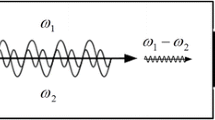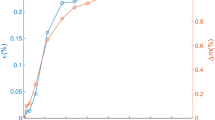Abstract
Deterioration of concrete due to the alkali–silica reaction (ASR) involves a reaction between alkaline ions in the cement pore solution and non-crystalline silica found in many aggregates. The product of reaction is a porous hydrophilic ASR gel, which causes expansion and cracking of concrete structure. Currently, there is no reliable method for non-destructive evaluation of ASR. We have investigated the feasibility of using relative dielectric permittivity obtained from X-band microwave backscattering of concrete. Advantages of this method of concrete evaluation are that measurements are non-contact and one-sided, and the approach is scalable to arbitrary-size concrete structures. The exploratory study was performed using an unrestrained set of accelerated ASR concrete prism specimens developed according to the ASTM1293 standard. One set of specimens contained no entrained air, while another set was contained entrained air. The specimens were removed from the environmental chamber at different times during a year-long study to create a set of different ASR maturity specimens. Strain measurements were performed on all specimens. Strain data both air entrained and non-air entrained sets were shown to be in close agreement with Larive model of isothermal unrestrained ASR expansion with similar fitting parameters. Relative dielectric permittivity of concrete specimens was correlated with strain data. Both sets show correlation between dielectric permittivity and strain, with stronger linear correlation observed for the air-entrained specimens. Development of such correlation would enable estimating expansion of actual concrete structures from microwave backscattering measurements, which could be used for risk stratification to guide and minimize coring.








Similar content being viewed by others
References
Ulm FJ, Cousy L, Larive C (2000) Thermo-chemo-mechanics of ASR expansion in concrete structures. J Eng Mech 126:233–242
Bazant ZP, Steffens A (2000) Mathematical model for kinetics of alkali-silica reaction in concrete. Cem Concr Res 30:419–428
Rajabipour F, Giannini E, Dunanat C, Ideker JH, Thomas MDA (2015) Alkali-silica reaction: current understanding of the reaction mechanisms and the knowledge gaps. Cem Concr Res 76:130–146
Saouma VE, Hariri-Ardebili MA, Le Pape Y, Balaji R (2016) Effect of alkali–silica reaction on the shear strength of reinforced concrete structural members. A numerical and statistical study. Nucl Eng Des 310:295–310
Multon S, Toutlemonde F (2006) Effect of applied stresses on alkali-silica reaction-induced expansions. Cem Concr Res 36:912–920
Alnaggar M, Cusatis G, Di Luzio G (2013) Lattice discrete particle modleing (LDPM) of alkali silica reaction (ASR) deterioration of concrete structures. Cem Concr Comp 41:45–59
ASTM C856–11 (2011) Standard practice for petrographic examination of hardened concrete. ASTM International, West Conshocken, Pennsylvania, USA
Rivard P, Saint-Pierre F (2009) Assessing alkali-silica reaction damage to concrete with non-destructive methods: from the lab to the field. Constr Build Mater 23:902–909
Ju T, Achenbach JD, Jacobs LJ, Guimares M, Qu J (2017) Ultrasonic nondestructive evaluation of alkali-silica reaction in concrete prism samples. Mater Struct 50:60
Rhim HC, Buyukozturk O (1998) Electromagnetic properties of concrete at microwave frequency range. ACI Mater J 95:262–271
Sandrolini L, Reggiani U, Ogunsola A (2007) Modleing the electrical properties of concerete for shielding effectiveness prediction. J Phys D: Appl Phys 40:5366–5372
Bourdi T, Rhazi JE, Boone F, Ballivy G (2012) Modelling dielectric-constant values of concrete: an aid to shielding effectiveness prediction and ground-penetrating radar wave technique interpretation. J Phys D: Appl Phys 45:405401
Jamil M, Hassan MK, Al-Mattarneh HMA, Zain MFM (2013) Concrete dielectric properties investigation using microwave nondestructive techniques. Mater Struct 46:77–87
Donnel KM, Zoughi R, Kurtis KE (2013) Demonstration of microwave method for detection of alkali-silica reaction (ASR) gel in cement-based materials. Cem Concr Res 44:1–7
Rashidi M, Knapp MCL, Hashemi A, Kim J-Y, Donnell KM, Zoughi R, Jacobs LJ, Kurtis KE (2016) Detecting alkali-silica reaction: a multiphysics approach. Cem Concr Compos 73:123–135
Hashemi A, Kurtis KE, Donnell KM, Zoughi R (2017) Empirical multiphase dielectric mixing model for cement-based materials containing alakali-silica reaction gel. IEEE Trans Instrum Meas 66:2428–2436
ASTM C1260–07 (2007) Standard test method for potential alkali reactivity of aggregates (Mortar Bar Method). ASTM International, West Conshohocken PA USA
ASTM C1293–08b (2008) Standard test method for determination of length change of concrete due to alkali-silica reaction. ASTM International, West Conshohocken PA USA
Heifetz A, Bakhtiari S, Lu J, Aranson IS, Vinokur VM, Bentivegna AF (2017) Development of microwave and impedance spectroscopy methods for in-situ nondestructive evaluation of alkali-silica reaction in concrete. AIP Conf Proc 1806:12003
Heifetz A, Bakhtiari S, Lu J, Bentivegna A (2017) Nondestructive evaluation of alkali-silica reaction in high-strength concrete for aging structure sustainability. Trans Am Nucl Soc 116:453–456
Bakhtiari S, Chien HT, Heifetz A, Elmer TW (2018) Nondestructive testing research and development efforts at Argonne National Laboratory: an overview. Mater Eval 76:911–920
Saouma VE, Martin RA, Hariri-Ardebili MA, Katayama T (2015) A mathematical model for the kinetics of the alkali-silica chemical reaction. Cem Concr Res 68:184–195
ASTM C231 (2017) Standard test method for air content of freshly mixed concrete by the pressure method. ASTM International, West Conshohocken PA USA
Liebe HJ, Hufford GA, Manabe T (1991) A model for complex permittivity of water at frequencies below 1THz. J Infrared Millim Te 12:659–675
Von Hippel AR (1995) Dielectric materials and applications. Artech House, Boston
Acknowledgements
Argonne National Laboratory’s work was supported by the Nuclear Energy Science and Technology Laboratory-Directed Research and Development (LDRD) program under contract DE-AC02-06CH11357.
Author information
Authors and Affiliations
Corresponding author
Ethics declarations
Conflict of interest
The authors declare that they have no conflict of interest.
Additional information
Publisher's Note
Springer Nature remains neutral with regard to jurisdictional claims in published maps and institutional affiliations.
Rights and permissions
About this article
Cite this article
Heifetz, A., Strow, M., Liu, Y. et al. Monitoring of dielectric permittivity in accelerated alkali-silica reaction concrete with microwave backscattering. Mater Struct 53, 130 (2020). https://doi.org/10.1617/s11527-020-01559-9
Received:
Accepted:
Published:
DOI: https://doi.org/10.1617/s11527-020-01559-9




